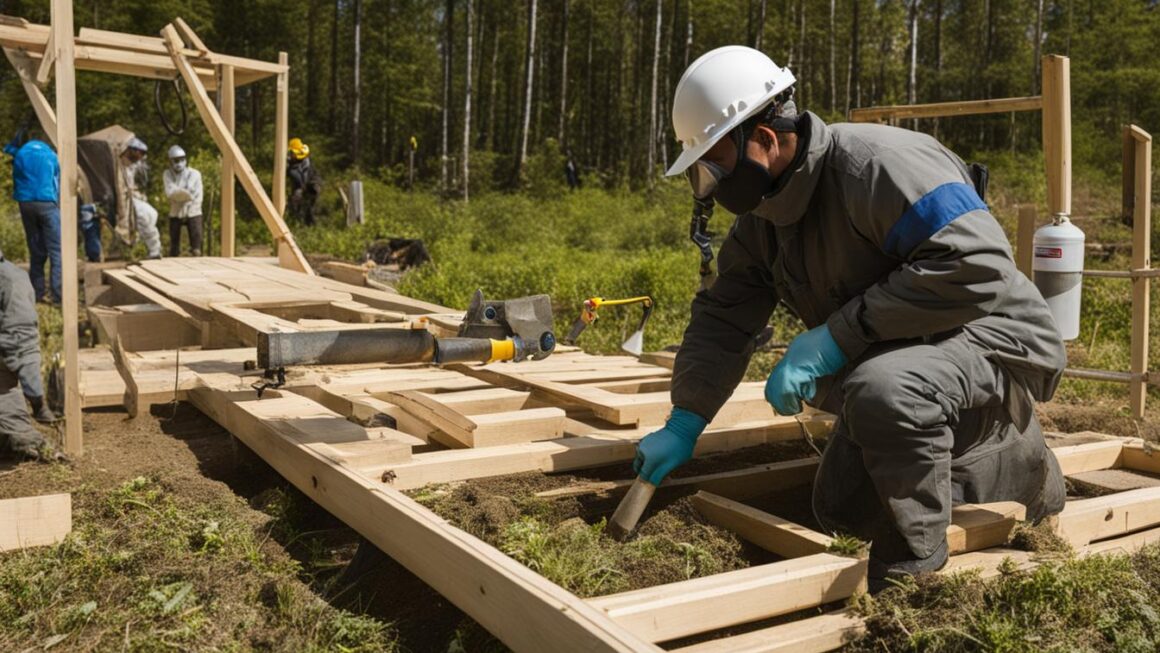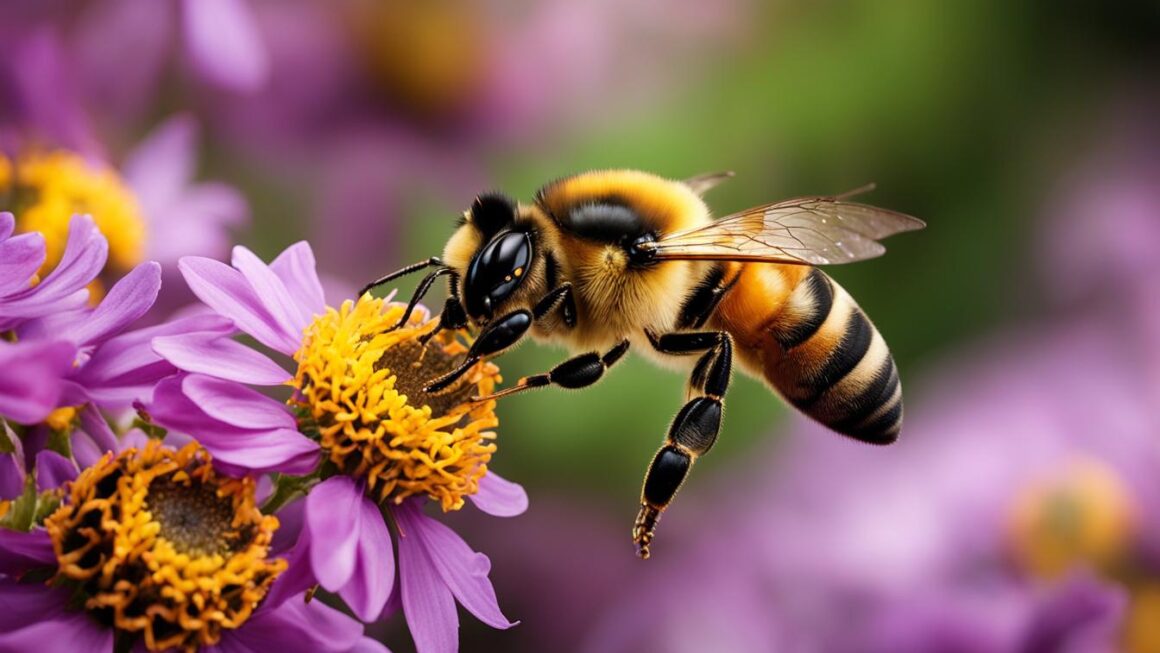Carpenter bees can cause significant damage to wooden structures, burrowing into the wood to create nests and lay eggs. If left unchecked, they can compromise the stability of the wood. It is important to identify carpenter bees and take action to treat and prevent infestations.
In this article, we will explore various methods to effectively treat carpenter bees and prevent future infestations. From using pesticides and natural remedies to implementing preventative measures, we will provide you with the knowledge and tools necessary to combat these destructive insects.
Key Takeaways:
- Identify carpenter bees by their size, shiny hairless abdomen, circular openings in wood, and sawdust or wood shavings near the openings.
- Carpenter bees damage wood by creating extensive tunnels that weaken the structure and attract woodpeckers.
- Pesticides, such as sprays and insecticidal dust, can effectively eliminate carpenter bees.
- Natural remedies, like carpenter bee traps and deterrents using citrus oil, can be used for non-toxic treatment.
- Prevent carpenter bee infestations by repairing holes, painting wood surfaces, and using hardwoods instead of softwoods.
How Carpenter Bees Damage Wood
Carpenter bees are known for the damage they can cause to wooden structures. These bees bore into wood to create nesting galleries, which can lead to structural issues if left untreated. While the holes they create may appear small on the surface, the galleries they create inside the wood can be much larger and more damaging than they initially appear.
The tunnels created by carpenter bees can extend for several feet, compromising the integrity of the wood. Over time, this can weaken the structure and make it more susceptible to further damage. Additionally, the presence of carpenter bees can attract woodpeckers, who are known to further damage the wood as they search for carpenter bee larvae.
To fully visualize the impact of carpenter bee damage, refer to the table below:
| Type of Damage | Description |
|---|---|
| Surface Holes | Circular openings created by carpenter bees on the exterior of the wood. |
| Galleries | Tunnels created by carpenter bees inside the wood, which can extend for several feet. |
| Weakness | Compromised structural integrity of the wood due to extensive carpenter bee damage. |
| Woodpecker Damage | Woodpeckers may be attracted to the presence of carpenter bees, causing further damage as they search for larvae. |
It is important to be proactive in identifying and treating carpenter bee infestations to prevent further damage to your wooden structures.
How to Identify Carpenter Bees and Carpenter Bee Damage
Carpenter bees can be distinguished from other bees by their larger size, measuring about 3/4-inch to 1-inch in length. They have shiny, hairless abdomens, and their coloring can range from black to metallic blue or green. Male carpenter bees can often be seen hovering around the nesting areas, engaging in aggressive flight patterns to defend their territory.
One of the key signs of carpenter bee infestation is the presence of circular openings in wood surfaces. These openings are approximately 1/2-inch in diameter and often have a distinct smooth edge. You may also notice sawdust or wood shavings near or below the openings, known as frass. Another indication is the presence of a yellow substance near or inside the entrance, which is a mixture of pollen and bee excrement.
When inspecting for carpenter bee damage, it’s important to look for multiple holes in a concentrated area, as these bees tend to prefer nesting in groups. Additionally, keep an eye out for signs of woodpecker activity, as they are attracted to the presence of carpenter bees and may further damage the wood as they search for larvae.
Carpenter Bee Pesticides
Carpenter bee pesticides are an effective solution for getting rid of carpenter bees and preventing further infestations. These pesticides can be used to specifically target the bees and treat the affected areas. It is important to choose the right type of pesticide and apply it correctly for optimal results.
Types of Carpenter Bee Pesticides
There are two main types of pesticides that are commonly used to control carpenter bees: sprays and insecticidal dusts.
- Sprays: Sprays are often used for treating newer carpenter bee infestations. They can be applied directly to and around the bee holes in the wood. The spray quickly kills the bees upon contact and helps to eliminate the immediate problem.
- Insecticidal Dusts: Insecticidal dusts are ideal for longer-term infestations. They can be applied deeper into the wood, reaching the nesting galleries where the bees lay their eggs. The dust stays effective for a longer period of time, providing ongoing protection against carpenter bees.
Using Carpenter Bee Pesticides Safely
When using carpenter bee pesticides, it is important to wear protective clothing such as gloves, goggles, and a mask to minimize exposure to the chemicals. Follow the instructions provided on the pesticide packaging carefully, ensuring that you apply the product in the recommended amounts and in the appropriate areas. Keep children and pets away from the treated areas until the pesticides have dried and any safety waiting periods have passed.
| Pesticide Type | Advantages | Considerations |
|---|---|---|
| Sprays | – Quick and effective – Target newer infestations |
– May require multiple applications – Limited long-term protection |
| Insecticidal Dusts | – Long-lasting protection – Reach deeper into the wood |
– May be more challenging to apply – May require professional assistance for deeper infestations |
By using carpenter bee pesticides properly and safely, you can effectively eliminate carpenter bee infestations and protect your wooden structures from further damage.
How to Get Rid of Carpenter Bees Naturally
For those looking for natural remedies and DIY solutions to treat carpenter bees, there are a variety of effective methods that can help eliminate these pests without the use of harsh chemicals. By combining several techniques, you can increase the chances of successfully ridding your property of carpenter bees.
One natural remedy is the use of carpenter bee traps. These traps are designed to attract the bees and capture them, preventing further damage to your wooden structures. Placing the traps near the bee holes or in areas where carpenter bee activity is high can help reduce their population.
In addition to traps, you can also use non-toxic liquids to encourage carpenter bees to leave their nests. Mixing citrus oil or almond oil with water and applying it around the bee holes can deter the bees from staying in the area. The strong scents of these oils are disliked by carpenter bees, prompting them to find a new location for their nests.
Another effective natural method is creating loud noises or vibrations near the bee-infested areas. Playing music or using vibrating devices can disrupt the bees’ nesting patterns, encouraging them to seek shelter elsewhere. This technique can be particularly useful for deterring carpenter bees from returning to previously infested areas.
Table: Natural Remedies for Carpenter Bees
| Method | Description |
|---|---|
| Carpenter Bee Traps | Capture bees and prevent further damage |
| Non-toxic Liquids | Apply citrus or almond oil around bee holes to repel bees |
| Loud Noises and Vibrations | Disrupt nesting patterns and encourage bees to leave |
It is important to note that while these natural methods can be effective, they may not completely eliminate all carpenter bees. For severe infestations, consulting with a professional pest control service may be necessary to ensure the problem is fully resolved. Additionally, taking preventive measures such as painting or varnishing exposed wood surfaces and repairing any existing damage can help deter carpenter bees from targeting your property in the first place.
By utilizing natural remedies and DIY treatments, you can take proactive steps to address carpenter bee infestations and protect your wooden structures from further damage.
How to Prevent Carpenter Bee Infestations
Carpenter bees can be a nuisance and cause damage to wooden structures. To prevent carpenter bee infestations, there are several effective measures you can take:
- Repair and Seal Holes: Regularly inspect wooden surfaces for any holes or openings where carpenter bees can enter. If you find any, repair them promptly using wood fillers and sealants. This will help deter carpenter bees from nesting in your wood.
- Paint or Varnish: Applying a coat of paint or varnish to the exterior of wooden structures can make them less attractive to carpenter bees. The protective layer creates a barrier that discourages bees from boring into the wood.
- Use Hardwoods: When possible, choose hardwoods like oak instead of softwoods like pine or cedar. Carpenter bees are less attracted to hardwoods, reducing the likelihood of infestation.
- Install Fine Mesh Screens: Covering exterior openings, such as vents and chimney caps, with fine mesh screens can prevent carpenter bees from gaining access to your home or other structures. It’s important to ensure the screens are tightly secured to effectively keep the bees out.
By implementing these preventive measures, you can minimize the risk of carpenter bee infestations and protect your wooden structures from damage.
Table: Comparison of Carpenter Bee Prevention Methods
| Prevention Method | Effectiveness | Cost | Ease of Implementation |
|---|---|---|---|
| Repair and Seal Holes | High | Low | Easy |
| Paint or Varnish | Medium | Medium | Moderate |
| Use Hardwoods | Medium | High | Moderate |
| Install Fine Mesh Screens | High | Medium | Moderate |
The Best Pest Control-Approved Method to Get Rid of Carpenter Bees
According to pest control professionals, the most effective method to get rid of carpenter bees is to use dust insecticides. These insecticides can be applied directly into the bee holes using a hand duster. Dust insecticides have a longer shelf life compared to liquid ones and provide swift results in eliminating carpenter bees. It is important to follow safety guidelines and take protective measures when using insecticides to ensure the well-being of both humans and the environment.
| Advantages of Dust Insecticides | Disadvantages of Dust Insecticides |
|---|---|
|
|
“Dust insecticides have proven to be the most reliable method for carpenter bee control. With their ability to penetrate deep into the bee holes, they effectively target the bees and eliminate the infestation. However, it is important to handle them with caution and follow the instructions provided to ensure safety.” – Pest Control Professional
While dust insecticides are the recommended method, it’s essential to take into account individual circumstances and consult with a professional before proceeding with any treatment. They can assess the severity of the infestation and provide appropriate recommendations for effective carpenter bee extermination.
Remember to prioritize safety and consider the potential impact on the environment when choosing and using any pest control method.
References:
- Pest Control Professional, [Name withheld for confidentiality]

Using Carpenter Bee Traps and Natural Repellents
Carpenter bee traps are an effective tool for capturing and removing carpenter bees from your property. These traps are designed to attract the bees and then trap them inside, preventing further damage to your wooden structures. Placing the traps directly over the bee holes is the most effective method for capturing the bees. Regularly empty and dispose of the trapped bees to maintain the trap’s effectiveness.
Natural repellents can also be used to deter carpenter bees from nesting in the first place. Citrus scents are particularly effective in repelling these bees. You can create a natural repellent by boiling citrus fruit rinds and applying the resulting liquid around the bee holes. Alternatively, mix citrus oil with water and spray it around the infested areas. The scent of citrus is unpleasant to carpenter bees and can discourage them from staying in the area.
| Carpenter Bee Traps and Natural Repellents | Advantages | Disadvantages |
|---|---|---|
| Carpenter bee traps | ✓ Effectively captures and removes carpenter bees | ✕ Requires regular maintenance and emptying of traps |
| Natural repellents | ✓ Uses safe and non-toxic ingredients | ✕ Requires frequent reapplication to maintain effectiveness |
It is important to note that carpenter bee traps and natural repellents may not completely eliminate carpenter bee infestations. These methods are best used in combination with other treatment and prevention techniques to achieve the most effective results. Regular inspections and maintenance of wooden structures are also crucial for long-term prevention of carpenter bee infestations.
Wildlife-Friendly and Eco-Friendly Methods to Get Rid of Carpenter Bees
If you’re looking for eco-friendly and wildlife-friendly methods to eliminate carpenter bees, there are several options to consider. These methods prioritize the well-being of both the environment and the wildlife while effectively deterring carpenter bees from your property.
One eco-friendly method is to use diatomaceous earth, a natural substance that can be applied directly into the nest holes. It is best to do this in the evening when the bees are less active. The diatomaceous earth works by dehydrating and suffocating the bees, effectively eliminating them without harming other beneficial insects.
Another eco-friendly approach is to use natural sprays made from citrus fruit or oil. Carpenter bees are repelled by the scent of citrus, so boiling citrus fruit rinds or mixing citrus oil with water and applying it around the bee holes can discourage them from staying in the area.
In addition to these direct methods, using sound or wind chimes can also help deter carpenter bees. The vibrations and noise produced by these objects can make the area less appealing for the bees to settle and create nests.
Benefits of Wildlife-Friendly and Eco-Friendly Methods
By utilizing wildlife-friendly and eco-friendly methods to get rid of carpenter bees, you are not only protecting the environment and preserving the natural balance but also avoiding the use of harmful chemicals that can have negative effects on other beneficial insects, birds, and animals. These methods provide an effective and sustainable way to control carpenter bee populations while ensuring the well-being of your surroundings.
How to Spot Carpenter Bee Damage and Infestation Signs
Carpenter bee damage can be easily identified through several telltale signs. Recognizing these signs is crucial for early detection and prompt treatment of infestations. By understanding what to look for, you can take the necessary steps to protect your wooden structures and prevent further damage.
Finding Smooth, Round Holes
- Carpenter bees create smooth, round holes in wood as their primary entrance and exit points. These holes are typically about 1/2 inch in diameter and resemble perfectly drilled circles.
- Inspect wooden structures such as decks, fences, and eaves for any visible holes. Be sure to check both the exterior and interior surfaces.
Noticing Sawdust or Frass
- As carpenter bees excavate their nesting galleries, they generate sawdust or frass, which is a mixture of wood particles and bee excrement.
- If you observe sawdust or frass near or below the holes, it is a clear indication of carpenter bee activity.
Enlarged or Reused Holes
- Carpenter bees may enlarge existing holes or reuse abandoned ones from previous seasons. This behavior can lead to further structural damage over time.
- Inspect the holes regularly to determine if they have been enlarged or reused. If you notice changes in size or evidence of multiple bees using the same hole, it is a sign of an active infestation.
By being vigilant and actively looking for these signs, you can quickly identify carpenter bee damage and take appropriate measures to address the infestation. Prompt treatment is essential to prevent further deterioration of the wood and minimize the risk of structural instability.
| Signs of Carpenter Bee Infestation | Carpenter Bee Damage Signs |
|---|---|
| Smooth, round holes in wood | Enlarged or reused holes |
| Sawdust or frass near the holes |
Quick Tips for Year-Round Carpenter Bee Prevention
Carpenter bees can be a nuisance, causing damage to wooden structures and compromising their integrity. To avoid these problems and keep your property free from carpenter bee infestations, it’s important to take consistent preventive measures. Here are some quick tips for year-round carpenter bee prevention:
- Regularly inspect wooden structures, such as decks, fences, and outdoor furniture, for any signs of carpenter bee activity. Look for circular openings in the wood, sawdust or frass around the holes, and the enlargement or reuse of older holes.
- Seal any existing bee holes with wood putty or caulk to prevent further infestation. This will also help eliminate any remaining bees inside the nest.
- Apply an insecticide spray or dust on vulnerable areas of unfinished wood, especially those that have been previously infested. Follow the manufacturer’s instructions and wear protective clothing when using pesticides.
- Consider using carpenter bee traps to capture and eliminate the bees. Place the traps near the bee holes for maximum effectiveness.
- Use natural repellents, such as citrus oil or water mixed with almond oil, around the bee holes to discourage carpenter bees from returning to the nest.
- Keep wooden surfaces well-painted or varnished, as bees are less likely to be attracted to treated wood.
By implementing these tips, you can significantly reduce the risk of carpenter bee infestations and protect your wooden structures from damage.

Why Take Preventive Measures
Prevention is key when it comes to dealing with carpenter bees. Taking proactive steps to deter them can save you from the hassle and costs of repairing damaged wood. By preventing carpenter bee infestations, you can preserve the integrity and lifespan of your wooden structures. It’s always easier to prevent a problem than to solve it.
The Importance of Regular Maintenance
Regular maintenance is crucial for effective carpenter bee prevention. Inspect your wooden structures at least once a year, especially during spring and early summer when carpenter bees are most active. Repair any cracks or holes in the wood promptly, as these can attract bees looking for nesting sites. By keeping your property well-maintained, you can minimize the risk of carpenter bee infestations.
Consulting with Professionals
If you’re dealing with a severe or persistent carpenter bee infestation, it may be best to consult with pest control professionals. They have the knowledge, experience, and tools to handle the problem effectively and safely. Professional extermination can provide long-term relief and peace of mind, ensuring that your wooden structures are protected against carpenter bee damage.
Conclusion
Carpenter bees can pose a significant threat to wooden structures, but with the right treatment and prevention methods, you can effectively eliminate and deter these pests. By implementing a combination of strategies, you can safeguard your property and avoid costly repairs.
One option is to use pesticides, such as sprays or insecticidal dust, to target carpenter bees directly. These methods can be effective in eliminating current infestations and preventing future ones. However, it’s important to take the necessary safety precautions and consider consulting with a professional for severe infestations.
If you prefer natural and eco-friendly methods, there are several options available. Carpenter bee traps can help capture and remove the bees from your property. You can also use non-toxic liquids, like citrus oil or almond oil, to encourage the bees to leave their nests. Additionally, creating loud noises or vibrations can deter carpenter bees from settling in the area.
To prevent carpenter bee infestations, it’s crucial to take proactive measures. Repairing holes and painting the wood after the bees have vacated can discourage their return. Applying varnish or paint to exposed wood surfaces can make them less attractive to carpenter bees. Covering exterior openings with mesh screens or caulk can also prevent bee incursions. Opting for hardwoods instead of softwoods can make the wood less appealing to these pests.
FAQ
How can I treat carpenter bees?
Carpenter bees can be treated with pesticides, traps, or natural repellents. Pesticides can be sprayed directly into the bee holes, while traps can capture the bees. Natural repellents, such as citrus oil or water with citrus oil, can be applied around the bee holes to encourage them to leave the nest.
How do carpenter bees damage wood?
Carpenter bees bore into wood to create nesting galleries. The tunnels they create can extend for several feet, compromising the stability of the wood. Female carpenter bees can cause extensive damage to wooden structures with their burrowing patterns.
How can I identify carpenter bees and carpenter bee damage?
Carpenter bees are larger than bumblebees and have shiny, hairless abdomens. Signs of carpenter bee infestation include circular openings in wood, sawdust or wood shavings around the openings, and a yellow substance near or inside the entrance. Carpenter bee damage can be identified by smooth, round holes in wood, frass or sawdust around the holes, and the enlargement or reuse of older holes.
What pesticides can be used to get rid of carpenter bees?
Pesticides can effectively eliminate carpenter bees. Sprays can be applied to and around the holes in the wood, targeting newer intrusions. Insecticidal dust can be applied more deeply into the wood and is ideal for longer-term infestations. It is important to wear protective clothing and take necessary precautions when using pesticides.
Are there natural remedies to get rid of carpenter bees?
Yes, there are several non-toxic and organic methods to get rid of carpenter bees. Carpenter bee traps can be used to capture the bees, while non-toxic liquids such as water with citrus oil or almond oil can be applied around the bee holes to encourage them to leave the nest. Loud noises and vibrations, such as playing loud music, can also deter carpenter bees. It is important to combine several techniques for optimal results.
How can I prevent carpenter bee infestations?
Taking preventative measures is key to avoiding carpenter bee infestations. Repairing holes and painting the wood after the bees have vacated can help prevent their return. Painting or varnishing exposed wood surfaces makes them less attractive to carpenter bees. Covering exterior openings with fine mesh screens or caulk can also prevent bee incursions. Using hardwoods like oak instead of softwoods like pine and cedar can make the wood less appealing to carpenter bees.
What is the most effective method to get rid of carpenter bees?
According to pest control professionals, dust insecticides are the most effective method to get rid of carpenter bees. These can be applied directly into the bee holes using a hand duster. Dust insecticides have a longer shelf life compared to liquid ones and provide swift results. It is important to follow safety guidelines and protective measures when using insecticides.
Can I use traps and natural repellents to deter carpenter bees?
Yes, carpenter bee traps can be purchased or homemade to capture the bees. Placing the traps directly over the bee holes can be effective. Natural repellents, such as citrus scents, can also deter carpenter bees. Boiling citrus fruit rinds or using citrus oil mixed with water can be applied around the bee holes. Creating a scent that carpenter bees dislike can discourage them from staying in the area.
Are there wildlife-friendly and eco-friendly methods to get rid of carpenter bees?
Yes, for those seeking wildlife-friendly and eco-friendly methods, there are several options. Diatomaceous earth can be applied directly into nest holes, particularly in the evening when the bees are less active. Natural sprays made from citrus fruit or oil can be used to deter carpenter bees. Using sound or wind chimes can also discourage them from settling in the area.
How can I spot carpenter bee damage and signs of infestation?
Carpenter bee damage can be identified by the presence of smooth, round holes in wood, sawdust or frass around the holes, and the enlargement or reuse of older holes. The burrowing patterns of female carpenter bees can cause extensive damage to wooden structures. Recognizing these signs is important for early detection and treatment.
What are some quick tips for year-round carpenter bee prevention?
Taking consistent preventive measures is crucial for year-round carpenter bee prevention. Spraying insecticides on vulnerable areas of unfinished wood, sealing openings and existing bee holes, and using traps or natural repellents can help keep carpenter bees at bay. Regular maintenance and inspections of wooden structures can also aid in preventing infestations.




